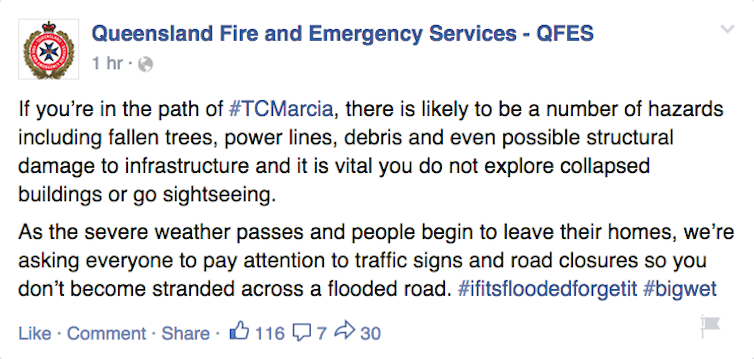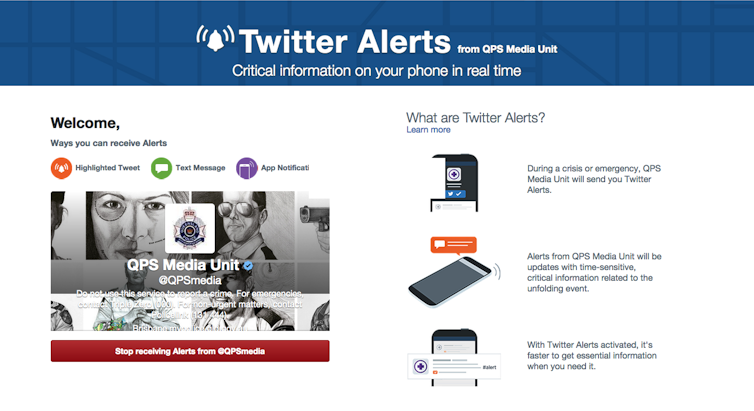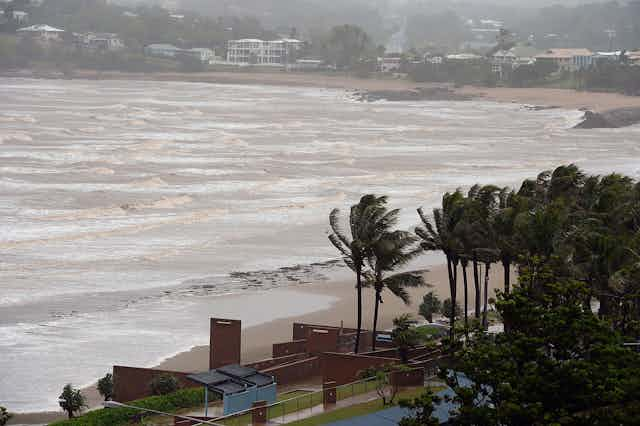The heavy rains and strong winds battering parts of Australia as Tropical Cyclones Marcia and Lam unleash their power are causing a rush of comments on social media.
As I write this article I’m sitting in the Queensland Fire and Emergency Services headquarters, in Brisbane, as part of my PhD research. I’m able to see first-hand the role that social media can play during natural disaster events.
More specifically, I’m observing how emergency management and other organisations can use various social media platforms to release timely and relevant information to those who need it.
These organisations can also use social media to gather intelligence from these platforms via geo-mapped Tweets and Instagram posts and, if necessary, respond to comments from people.

During recent natural disasters, social media have played an increasingly popular role in the crisis communication ecology. Research has shown how affected members of the public use these platforms to share up-to-date information and images on their status with friends and family.
TC Marcia is already impacting towns along the coast of central Queensland, including Yeppoon, Rockhampton and Gladstone today. TC Marcia is expected to bring extensive rainfall and possible flooding to the southeast corner of Queensland and as far south as northern New South Wales over the weekend.
On Twitter, key trending topics and hashtags include #TCMarcia and derivatives of the term (#cyclonemarcia, #bigwet). Key terms and locations relating to the event include things such as “Category 5” and “St Lawrence”.
In the Northern Territory the hashtag #TCLam is trending as TC Lam moves across the region.
Social media posts are useful at various stages of a disaster. In the past few days we’ve seen extensive activity from local councils on their Facebook pages. We’ve also seen activity from key disaster response agencies, including the Queensland Fire and Emergency Services and the Queensland Police Service in preparation for the cyclone.
But how these agencies respond to the event using social media while it is happening and afterwards, in the recovery phase, is particularly interesting. Social media can help communities organise recovery efforts and make it easier for agencies to conduct their role.
People are even encouraged – only when it is safe to do so – to post photos of any cyclone damage on Twitter, including @QldFES in the Tweet, to make it easier for emergency services to monitor. The acting commissioner of Queensland Fire and Emergency Services, Katarina Carroll, told Channel Nine that was a big help:
It gives us a true picture of what’s happening out there so we encourage people to definitely do that. We use our own internal social media to do that and our own way of getting imagery back into the centre, but certainly it gives us a fuller and more comprehensive picture of what’s occurring out there.
The push and pull of information
Researchers and owners and operators of social media platforms are quickly responding to the growing use of social media during natural disasters and unusual events, developing tools to more effectively push and pull information from these platforms.
Towards the end of last year, we wrote about the role that social media platform owners and operators play in a natural disaster. Facebook’s new platform Safety Check allows users to notify their network of their safety status during a natural disaster.
While this platform is of particular use to affected individuals, its benefit to disaster response agencies is, for the moment, unknown. It was not developed in consultation with emergency management organisations, which means the data is likely inaccessible to these agencies.
In contrast, the launch of Twitter Alerts in September 2013 opened up new possibilities to increase the visibility of emergency management organisations’ important messages to their followers.
Twitter alerts allow pre-approved law enforcement (such as the Queensland Police service, below), emergency management and government agencies to send critical information – such as warnings, evacuation instructions and safety messages – to their subscribers via a push notification or an SMS message (for those who subscribe to the latter service).

When the service first launched I outlined some considerations for agencies wanting to use it and particular limitations of the service.
We’re yet to see extensive use of Twitter alerts, particularly here in Australia. However, the Queensland Police Service did release its first Twitter alert earlier this month after the service had cancelled a child abduction alert (CAA) for a child who was previously reported as missing.
It’s worth noting, though, that this alert was issued to notify followers that the missing child had been located (likely to prevent the further spread of the child abduction alert), rather than when the CAA was first released.
It’s this type of self-directed use that makes services such as Twitter alerts, while interesting, potentially problematic. There is the possibility of inconsistent use across all users.
In the case of disasters, one agency may release a Twitter alert only for life-threatening events, while another agency may issue them frequently for all warnings, potentially lessening the impact of this service for some recipients.
Is social media revolutionising crisis communication?
There will likewise always be concerns about the spread of rumour and misinformation on social media during an event. There are also risks for a select few who post on social media when in danger rather than call emergency services on 000.
Of course, any posting device’s need for power and an internet signal or network connection to get information out on social media is always a challenge, especially during severe weather events where power and network outages are common.
So it’s important to note that proponents of social media don’t consider it a replacement for traditional forms of communication, particularly those located in remote or isolated communities.
Rather, it is a useful addition to a crisis communication toolbox, which opens up possibilities for communicating in new and innovative ways. It offers potential for disaster response agencies to receive live, on-the-ground intelligence from those directly affected.
But users shouldn’t rely on social media as their only information source. At the end of the day, if all else fails, there’s always the trusty battery-powered radio.
Useful information
For Tropical Cyclone Maria follow @QldFES, @QPSmedia and @BOM_Qld and the hashtag #TCMarcia on Twitter.
Sign up to receive Twitter alerts from Queensland Police and Queensland Fire and Emergency Services.
For Tropical Cyclone Lam follow @ntpolice, @BOM_NT and the hashtag #TCLam on Twitter.
If you’re in the affected area and require assistance call the SES on 132 500.
In a life-threatening emergency always call Triple Zero (000).

